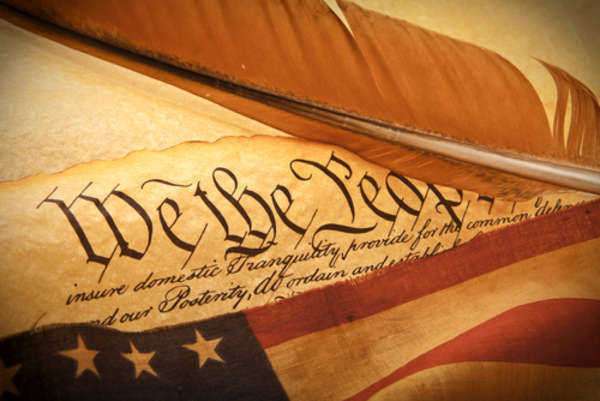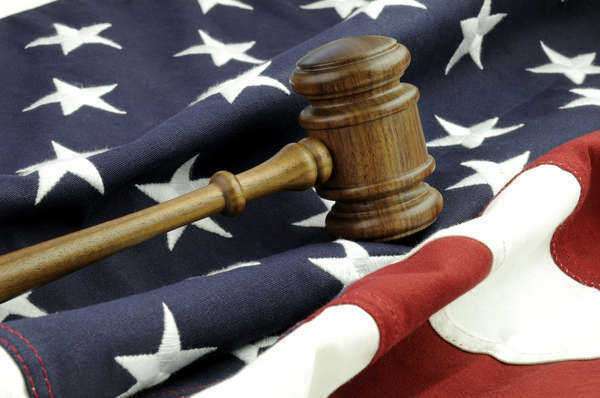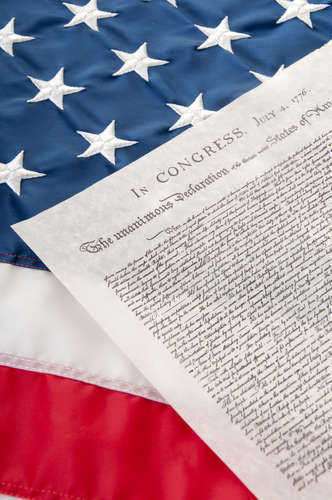
14th Amendment – Simplified Overview, Cases & Decisions, Timeline
Introduction
The 14th Amendment of the United States Constitution, ratified in 1868, was a landmark addition to the Constitution. This post-Civil War amendment abolished slavery and affirmed citizenship for all persons born or naturalized in the United States. Since its passage, the 14th Amendment has had far-reaching impacts on American law, guiding many Supreme Court decisions on issues such as civil rights, due process, and incorporation of the Bill of Rights to the states. In this article, we will explore the timeline of how the 14th Amendment has influenced major court decisions through time.
1868: The Passage of the 14th Amendment
The 14th Amendment was adopted in response to concerns that Southern states would not extend civil rights to freed slaves following the end of the Civil War. The amendment laid out that “all persons born or naturalized in the United States” were entitled to citizenship, and ensured that states could not deprive any person of life, liberty, or property without due process of law or deny any person “equal protection of the laws.”
1873: The Slaughter-House Cases
The Slaughter-House Cases were the first Supreme Court case to address the 14th Amendment. The case involved the regulation of the livestock industry in New Orleans and whether a new Louisiana law granted a monopolistic slaughterhouse privilege, violating the rights of other butchers who were now subject to fees for using the monopoly system. The Supreme Court ruled that the privileges and immunities clause of the 14th Amendment did not automatically apply the Bill of Rights to state law. Instead, the privileges and immunities referred to fundamental rights of national citizenship, such as the right to travel freely between states or petition Congress for redress of grievances. The Court also held that the amendment did not transfer all previously state-specific rights to the national government.
1896: Plessy v. Ferguson
Plessy v. Ferguson is well known for legitimizing the “separate but equal” doctrine, which provided legal justification for segregation in the United States. Homer Plessy, who was one-eighth Black, was arrested for refusing to leave a “Whites Only” train car in Louisiana. His case ultimately reached the Supreme Court, which upheld Louisiana’s law segregating rail passengers by race. The Court held that the segregation did not violate the Equal Protection Clause of the 14th Amendment because the separate accommodations provided for each race were inherently equal. The ruling of Plessy v. Ferguson established “separate but equal” as the law of the land until it was overruled almost sixty years later by Brown v. Board of Education.
1913: The Incorporation Debate
In the early 20th century, there was a debate over whether the Bill of Rights applied to state law through the 14th Amendment. Progressives, labor unions, and civil rights advocates pushed for incorporation, arguing that the Due Process Clause of the 14th Amendment safeguarded individual rights from state encroachment. On the other hand, conservative lawyers, some judges, and some legal scholars argued that the 14th Amendment was only intended to restrict discriminatory practices by states and not to limit their legislative powers. This issue was not fully resolved until mid-20th century.
1923: Moore v. Dempsey
In 1919, labor strikes and racial tensions in Elaine, Arkansas sparked a wave of violence that left between 100 and 240 African Americans dead in what has come to be known as the “Elaine Massacre.” Three years later, a group of African American defendants were unfairly convicted of murder and sentenced to death without a proper trial. In Moore v. Dempsey, the Supreme Court granted a writ of habeas corpus, ordering a new trial and ruling that the Due Process Clause of the 14th Amendment required that courts ensure that only defendants who received a fair trial could be sentenced to death.
1954: Brown v. Board of Education
Brown v. Board of Education is one of the most important judicial decisions in American history, placing the Supreme Court at the forefront of the Civil Rights Movement. The case challenged racial segregation in public schools in Topeka, Kansas. In the landmark unanimous decision, the Court found that segregation in public schools violated the Equal Protection Clause of the 14th Amendment. The ruling declared that “separate educational facilities are inherently unequal,” and overturned the “separate but equal” doctrine established by Plessy v. Ferguson. Brown v. Board of Education was a crucial step towards desegregation and equality in American society.
1961: Mapp v. Ohio
Mapp v. Ohio extended the exclusionary rule, which prohibits the use of illegally obtained evidence in court, to state law through the 14th Amendment’s Due Process Clause. Dollree Mapp was convicted of obscenity charges after police searched her home without a warrant in search of a fugitive. The Supreme Court held that evidence obtained through an illegal search and seizure could not be used during a criminal trial, regardless of relevance to a case. This decision was a significant expansion of protection offered by the Fourth Amendment.
1963: Gideon v. Wainwright
Gideon v. Wainwright is a landmark case that established the right to an attorney for criminal defendants who cannot afford one. Clarence Earl Gideon, an indigent Florida man, was arrested for burglary but was denied an attorney in court. Representing himself, Gideon was convicted and sentenced to five years in prison. The Supreme Court held that the Due Process Clause of the 14th Amendment required the provision of legal counsel in all criminal trials, regardless of the defendant’s income.
1968: Terry v. Ohio
Terry v. Ohio set the standard for “stop and frisk” searches performed by police in the United States. John W. Terry was stopped and searched by an officer after appearing to case the outside of a store. The Supreme Court found that the officer had not conducted a search under the Fourth Amendment, as he had reasonable suspicion that Terry was about to commit a crime. The ruling established the use of “stop and frisk” as a legal practice as long as law enforcement officers follow proper protocol and require a “reasonable suspicion.”
1973: Roe v. Wade
Roe v. Wade is a pivotal Supreme Court case concerning women’s reproductive rights. The case centered on a Texas woman, Jane Roe, who wished to terminate her pregnancy but was prevented by Texas law. The Supreme Court held that the right to privacy, protected by the Due Process Clause of the 14th Amendment, included a woman’s right to have an abortion. The decision was controversial, galvanizing pro-life and pro-choice movements in the United States.
2015: Obergefell v. Hodges
Obergefell v. Hodges concerned marriage equality for same-sex couples and ruled that the Equal Protection Clause of the 14th Amendment required states to license and recognize their marriage. Jim Obergefell had sued the state of Ohio for refusing to recognize his marriage to his partner of 21 years, who had recently died of ALS, leaving Obergefell with no legal right to claim his partner’s death certificate or grave. The Supreme Court held that the Fourteenth Amendment guarantees equal dignity and equal protection under the law, thereby legalizing same-sex marriage across the United States.
Conclusion
The 14th Amendment’s guarantee of equal protection and due process has played a crucial role in protecting individual rights in America. While it took decades for the amendment’s full potential to be realized, it has provided a foundation for many of the landmark court cases that have shaped American society. Whether in racial desegregation, women’s rights, or marriage equality, the 14th Amendment has provided a framework that has steered the country towards progress and equality.
Overview of the 14th Amendment – Simplified and Explained
Introduction
The 14th Amendment to the United States Constitution is a pivotal piece of legislation that has had a profound impact on American society since its ratification in 1868. This amendment addresses fundamental issues of citizenship, equal protection under the law, and due process, and it has been the cornerstone of numerous landmark Supreme Court cases. In this article, we will provide a simplified and comprehensive explanation of the 14th Amendment, drawing on government resources and historical context to help you understand its significance.
- Historical Context
To fully grasp the importance of the 14th Amendment, we must first delve into the historical backdrop against which it was crafted. The American Civil War, which raged from 1861 to 1865, left the nation deeply divided. The South had seceded from the Union over issues primarily related to slavery and states’ rights. Abraham Lincoln’s Emancipation Proclamation in 1863 declared all slaves in Confederate territory to be free, but the war itself was essential in pushing the nation toward the abolition of slavery.
After the Civil War, the Reconstruction Era (1865-1877) aimed to rebuild the South and secure the rights of newly freed slaves. During this tumultuous period, Southern states enacted a series of laws known as the “Black Codes” that restricted the rights and freedoms of African Americans. These discriminatory laws prompted Congress to take action.
- Citizenship Clause (Section 1)
The 14th Amendment begins with the Citizenship Clause, which is perhaps its most well-known provision. Section 1 states: “All persons born or naturalized in the United States and subject to the jurisdiction thereof, are citizens of the United States and of the State wherein they reside.” This clause overturns the infamous Dred Scott v. Sandford decision of 1857, which declared that African Americans, whether enslaved or free, could not be citizens.
The Citizenship Clause established birthright citizenship, ensuring that anyone born on U.S. soil or naturalized becomes a citizen. This principle has been instrumental in providing equal rights and opportunities for all individuals, regardless of their racial or ethnic background.
III. Due Process Clause (Section 1)
The Due Process Clause, also found in Section 1, is another crucial element of the 14th Amendment. It declares that no state shall “deprive any person of life, liberty, or property, without due process of law.” This clause safeguards the fundamental rights and liberties of all individuals by requiring that legal proceedings be conducted fairly and justly.
Throughout American history, the Due Process Clause has played a pivotal role in protecting citizens from unjust government actions. It ensures that individuals are afforded a fair trial, have the right to legal counsel, and cannot be subjected to cruel or unusual punishment. This clause has been at the center of numerous landmark Supreme Court cases, including Roe v. Wade and Miranda v. Arizona.
- Equal Protection Clause (Section 1)
The Equal Protection Clause, also part of Section 1, has been a cornerstone of civil rights litigation in the United States. It states that no state shall “deny to any person within its jurisdiction the equal protection of the laws.” This clause was specifically aimed at eradicating racial discrimination, but its implications extend to all forms of discrimination.
The Equal Protection Clause has been invoked in cases ranging from school desegregation (Brown v. Board of Education) to marriage equality (Obergefell v. Hodges). It demands that all individuals be treated equally under the law, irrespective of their race, gender, or any other protected characteristic.
- Privileges and Immunities Clause (Section 1)
The Privileges and Immunities Clause, also found in Section 1, is often less well-known than the other clauses but is nonetheless significant. It states that no state shall make or enforce any law that abridges the “privileges or immunities” of U.S. citizens. This clause was intended to prevent states from infringing on the basic rights and privileges of American citizens.
However, this clause has been less frequently litigated than the other three clauses, and its scope has been the subject of debate. While it was initially meant to protect fundamental rights, the Supreme Court has interpreted it narrowly in several cases. Nonetheless, it remains a part of the 14th Amendment’s text and can potentially be used to challenge state laws that infringe on citizens’ privileges and immunities.
- The Ratification Process
The road to ratifying the 14th Amendment was not without its challenges. After its proposal in 1866, the amendment required ratification by three-fourths of the states to become part of the Constitution. Several Southern states were initially hesitant to ratify it, and the amendment faced significant opposition. However, it was ultimately ratified on July 9, 1868, when the necessary number of states approved it.
The ratification of the 14th Amendment marked a critical turning point in American history. It sought to guarantee civil rights and equal protection to all citizens, particularly newly freed slaves in the South.
VII. The Incorporation Doctrine
One of the enduring debates related to the 14th Amendment is its applicability to state governments. While the amendment was originally intended to address the actions of state governments in the aftermath of the Civil War, it has since been invoked to hold states accountable for violating individuals’ rights.
This concept is known as the Incorporation Doctrine, and it relies on the Due Process Clause of the 14th Amendment. The doctrine holds that certain rights recognized in the Bill of Rights, such as freedom of speech and the right to a fair trial, are “incorporated” and therefore apply to the states through the 14th Amendment. This doctrine has expanded the protection of individual rights at the state level and continues to be a central issue in constitutional law.
VIII. Supreme Court Cases and the 14th Amendment
The 14th Amendment has been the foundation for numerous landmark Supreme Court decisions that have shaped American society. Here are a few notable cases:
- Brown v. Board of Education (1954): This case declared state laws establishing separate public schools for black and white students to be unconstitutional, effectively ending racial segregation in public education.
- Loving v. Virginia (1967): The Supreme Court struck down laws prohibiting interracial marriage, ruling that such bans violated the Equal Protection Clause of the 14th Amendment.
- Roe v. Wade (1973): This case established a woman’s right to choose to have an abortion as protected under the Due Process Clause of the 14th Amendment.
- Obergefell v. Hodges (2015): The Supreme Court legalized same-sex marriage across all 50 states, citing the Equal Protection Clause of the 14th Amendment as a basis for the decision.
These cases, among others, demonstrate how the 14th Amendment continues to be a dynamic and evolving force in American jurisprudence, shaping the legal landscape and promoting equality.
- Contemporary Relevance
The principles enshrined in the 14th Amendment remain central to contemporary debates and challenges. Issues related to equal protection, due process, and citizenship continue to be litigated in courts across the country. The amendment’s impact can be seen in discussions surrounding immigration, LGBTQ+ rights, voting rights, and criminal justice reform.
For example, ongoing debates over voter ID laws and gerrymandering often hinge on the Equal Protection Clause. The amendment’s Due Process Clause is frequently invoked in cases related to police misconduct and the rights of criminal defendants.
Furthermore, discussions about birthright citizenship and immigration policies often reference the Citizenship Clause of the 14th Amendment. While the amendment was originally intended to address the rights of newly freed slaves, its broad language has made it applicable to a wide range of issues.
Conclusion
The 14th Amendment stands as a testament to the enduring struggle for civil rights and equality in the United States. Born out of the tumultuous aftermath of the Civil War, it has been the bedrock of legal principles that have transformed American society. Its Citizenship, Due Process, Equal Protection, and Privileges and Immunities Clauses continue to guide the nation’s pursuit of justice and fairness for all its citizens.
As we navigate the complex and evolving challenges of the 21st century, the 14th Amendment serves as a reminder of the principles upon which the United States was founded: liberty, equality, and justice for all. Its continued relevance underscores the importance of understanding its history and implications, as it remains a powerful tool in the ongoing quest for a more just and equitable society.
The 14th Amendment: State Laws and the Pursuit of Equal Protection
Introduction
The 14th Amendment to the United States Constitution stands as a milestone in American legal history, championing the principles of equal protection and due process under the law. Ratified in 1868, this amendment reshaped the legal landscape of the United States by addressing citizenship rights and extending federal protections to all individuals. This comprehensive exploration delves into how the 14th Amendment’s provisions resonate within the legal frameworks of several US states, ensuring equal rights and protections for their residents.
Alabama: Ensuring Equal Citizenship
Alabama’s laws emphasize the importance of the 14th Amendment in ensuring equal citizenship for all residents. The state’s commitment to upholding the amendment’s principles underscores its dedication to providing equal rights and protections under the law.
Alaska: Embracing Due Process
Alaska’s legal framework reflects its embrace of due process, a key principle of the 14th Amendment. The state prioritizes the fair treatment of individuals, aligning with the amendment’s emphasis on safeguarding the rights of all citizens.
Arizona: Upholding Equal Protection
Arizona’s laws highlight its dedication to upholding equal protection for all residents, as enshrined in the 14th Amendment. The state’s legal provisions reflect its commitment to ensuring that all individuals receive fair and equitable treatment under the law.
Arkansas: Safeguarding Individual Liberties
Arkansas’ legal landscape emphasizes the importance of safeguarding individual liberties as per the 14th Amendment. The state ensures that residents are granted due process and equal protection, reflecting the amendment’s core principles.
California: Championing Equal Rights
California’s approach to the 14th Amendment reflects its dedication to championing equal rights for all. The state’s laws prioritize ensuring that all individuals, regardless of their background, receive fair and just treatment under the law.
Colorado: Fostering Equal Treatment
Colorado’s laws emphasize fostering equal treatment and protection for all individuals, mirroring the 14th Amendment’s provisions. The state’s commitment to due process and equal protection resonates within its legal framework.
Connecticut: Upholding Due Process
Connecticut’s legal landscape underscores its commitment to upholding due process as outlined in the 14th Amendment. The state ensures that individuals are afforded fair and just treatment in legal proceedings.
Delaware: Embracing Equal Citizenship
Delaware’s laws reflect its embrace of equal citizenship for all residents, a principle reinforced by the 14th Amendment. The state prioritizes the protection of individual rights and equal treatment under the law.
Florida: Ensuring Equal Protection
Florida’s legal framework highlights its commitment to ensuring equal protection for all residents, a cornerstone of the 14th Amendment. The state’s laws reflect its dedication to upholding the rights and liberties of its citizens.
Georgia: Safeguarding Due Process
Georgia’s laws emphasize the importance of safeguarding due process, a core principle of the 14th Amendment. The state’s legal provisions prioritize providing fair and equitable treatment to individuals within its jurisdiction.
Hawaii: Equal Protection and Due Process
Hawaii, like other states, recognizes the significance of the 14th Amendment in shaping state laws. The state’s legal landscape emphasizes equal protection and due process, ensuring that all residents are treated fairly and afforded their rights. Hawaii’s laws reflect the 14th Amendment’s role in upholding civil liberties, regardless of background or status.
Idaho: Incorporation of Rights
Idaho’s laws reflect the state’s commitment to incorporating the principles of the 14th Amendment into its legal framework. The state ensures that fundamental rights, guaranteed by the Constitution, are extended to its residents. Idaho’s legal landscape showcases the amendment’s role in protecting individual freedoms.
Illinois: Equal Rights and Non-Discrimination
Illinois’ approach to the 14th Amendment underscores its dedication to equal rights and non-discrimination. The state’s laws prioritize the protection of civil liberties and the prohibition of unjust treatment. Illinois recognizes the amendment’s significance in creating a just and inclusive society.
Indiana: Due Process and Birthright Citizenship
Indiana’s laws emphasize the importance of due process and birthright citizenship as outlined in the 14th Amendment. The state ensures that individuals are afforded their rights and that citizenship is granted to those born within its borders. Indiana’s legal framework reflects the amendment’s impact on citizenship and individual protections.
Iowa: Ensuring Equal Treatment
Iowa’s legal landscape echoes the principles of the 14th Amendment by ensuring equal treatment for all residents. The state’s laws prioritize the elimination of discrimination and emphasize the importance of a just and inclusive society. Iowa recognizes the amendment’s role in shaping state laws that uphold civil liberties.
Kansas: Incorporating Fundamental Rights
Kansas’ laws reflect the state’s incorporation of fundamental rights guaranteed by the 14th Amendment. The state prioritizes the protection of individual freedoms and ensures that all residents are afforded equal treatment under the law. Kansas’ legal framework underscores the amendment’s impact on shaping state-level protections.
Kentucky: Protecting Civil Liberties
Kentucky’s approach to the 14th Amendment emphasizes the protection of civil liberties and equal treatment. The state’s laws reflect its commitment to non-discrimination and ensuring that all residents have access to their constitutional rights. Kentucky recognizes the amendment’s role in shaping state laws that promote justice and fairness.
Louisiana: Due Process and Equal Protection
Louisiana’s legal landscape underscores the principles of due process and equal protection as outlined in the 14th Amendment. The state’s laws prioritize the preservation of civil liberties and the elimination of unjust treatment. Louisiana recognizes the amendment’s impact on shaping state-level protections and ensuring justice for all residents.
Maine: Birthright Citizenship and Equal Rights
Maine’s laws reflect the state’s commitment to birthright citizenship and equal rights as guaranteed by the 14th Amendment. The state ensures that individuals born within its borders are granted citizenship and that all residents are treated fairly under the law. Maine’s legal framework highlights the amendment’s role in shaping state-level protections.
Maryland: Incorporation of Civil Liberties
Maryland’s approach to the 14th Amendment emphasizes the incorporation of civil liberties into its legal framework. The state’s laws prioritize the protection of individual freedoms and the prohibition of unjust treatment. Maryland recognizes the amendment’s impact on shaping state laws that uphold civil liberties and ensure equal treatment.
Massachusetts: Equal Protection and Due Process
Incorporating the principles of the 14th Amendment, Massachusetts state laws uphold the rights of its citizens by ensuring equal protection and due process. The state’s legal framework echoes the amendment’s guarantee that no person shall be denied equal protection under the law. Massachusetts has implemented measures to prevent discrimination and provide remedies for those whose rights have been violated. This commitment to equality is a testament to the enduring influence of the 14th Amendment on the state’s legal landscape.
Michigan: Birthright Citizenship and Privileges or Immunities
Michigan’s state laws align with the 14th Amendment’s recognition of birthright citizenship and the protection of privileges or immunities. The state upholds the principle that all individuals born or naturalized in the United States are citizens, regardless of their background. Furthermore, Michigan ensures that the privileges and immunities of its citizens are safeguarded, contributing to a just and inclusive society that reflects the values of the 14th Amendment.
Minnesota: Due Process and Equal Protection in State Laws
Minnesota’s state laws reflect a commitment to due process and equal protection, mirroring the 14th Amendment’s provisions. The state emphasizes that individuals within its jurisdiction are entitled to a fair legal process and the same protections under the law, regardless of their circumstances. Minnesota’s legal framework is a testament to the enduring significance of the 14th Amendment’s principles in shaping state governance.
Mississippi: Incorporation of Civil Liberties=
Mississippi’s state laws incorporate civil liberties in line with the 14th Amendment’s guarantee of individual rights. The state upholds the principle that no state shall make or enforce laws that abridge the privileges or immunities of citizens. Mississippi’s legal framework ensures that its residents enjoy the rights enshrined in the Constitution, contributing to a more equitable and just society.
Missouri: Due Process and State Legal System
Missouri’s state laws uphold the principles of due process in accordance with the 14th Amendment. The state ensures that individuals facing legal proceedings are afforded a fair and impartial process, consistent with the amendment’s guarantees. Missouri’s legal system reflects a commitment to justice that aligns with the foundational principles of the 14th Amendment.
Montana: Equal Protection Under State Laws
Montana’s state laws emphasize equal protection under the law, echoing the principles of the 14th Amendment. The state upholds the idea that every individual within its jurisdiction is entitled to the same legal protections and opportunities, irrespective of their background. Montana’s legal framework exemplifies the enduring influence of the 14th Amendment’s commitment to equality.
Nebraska: Incorporation of Fundamental Rights
Nebraska’s state laws incorporate fundamental rights in accordance with the 14th Amendment’s due process clause. The state ensures that individuals are protected from actions that infringe upon their essential rights. Nebraska’s legal framework exemplifies the amendment’s enduring role in safeguarding the liberties of its citizens.
Nevada: Equal Protection and Anti-Discrimination Measures
Nevada’s state laws align with the 14th Amendment’s emphasis on equal protection and anti-discrimination. The state ensures that all individuals are treated fairly and without discrimination under the law, reflecting the amendment’s principles. Nevada’s legal framework contributes to a more inclusive and just society that upholds the values of the 14th Amendment.
New Hampshire: State-Level Due Process and Equal Protection
New Hampshire’s state laws prioritize due process and equal protection, consistent with the 14th Amendment’s provisions. The state emphasizes that individuals within its jurisdiction are entitled to fair legal procedures and the same protections under the law. New Hampshire’s legal framework underscores the enduring significance of the 14th Amendment’s principles in shaping state governance.
New Jersey: Protection of Civil Rights and Liberties
New Jersey’s state laws prioritize the protection of civil rights and liberties in accordance with the 14th Amendment’s guarantees. The state ensures that its residents are safeguarded from actions that infringe upon their fundamental rights. New Jersey’s legal framework exemplifies the enduring influence of the 14th Amendment in upholding the rights of its citizens.
New Mexico: Equal Protection and Due Process
Incorporating the principles of the 14th Amendment, New Mexico’s state laws emphasize the significance of equal protection and due process. The state ensures that all individuals within its jurisdiction are entitled to the same legal rights and that legal proceedings are carried out fairly and justly. By mirroring the 14th Amendment’s emphasis on safeguarding individual liberties, New Mexico’s laws reflect a commitment to a just and equitable society.
New York: Defending Civil Rights
New York’s state laws are deeply rooted in the 14th Amendment’s mission to protect civil rights. The state prioritizes the prohibition of discrimination based on race, gender, and other protected characteristics. New York’s legal framework underscores the importance of fostering an inclusive and diverse society, in alignment with the principles enshrined in the 14th Amendment.
North Carolina: Balancing State and Federal Jurisdiction
North Carolina’s laws navigate the balance between state and federal jurisdiction as guided by the 14th Amendment. The state recognizes the amendment’s mandate to protect individual rights and liberties while respecting the boundaries of state authority. North Carolina’s legal landscape reflects its commitment to upholding the principles of the 14th Amendment while preserving its distinct legal autonomy.
North Dakota: Ensuring Due Process
North Dakota’s state laws uphold the principles of due process as outlined in the 14th Amendment. The state emphasizes the importance of fair legal proceedings and ensures that individuals are provided adequate notice and an opportunity to be heard. By aligning with the 14th Amendment, North Dakota’s legal system promotes the principles of justice and fairness.
Ohio: Incorporating Equal Protection
Ohio’s legal framework reflects the incorporation of equal protection principles as established by the 14th Amendment. The state’s laws prioritize the elimination of discriminatory practices and ensure that all individuals are treated fairly and without bias. Ohio’s commitment to equal protection resonates with the 14th Amendment’s goal of promoting equality under the law.
Oklahoma: Recognizing Individual Liberties
Oklahoma’s state laws are rooted in the recognition of individual liberties protected by the 14th Amendment. The state ensures that fundamental rights are safeguarded, and legal processes are carried out with respect for due process. By aligning with the principles of the 14th Amendment, Oklahoma’s legal system prioritizes the protection of individual rights and freedoms.
Oregon: Guarding Against Discrimination
Oregon’s laws guard against discrimination in line with the 14th Amendment’s mandate. The state emphasizes the prohibition of unequal treatment and ensures that all individuals are afforded equal rights under the law. By reflecting the principles of the 14th Amendment, Oregon’s legal framework promotes inclusivity and combats discriminatory practices.
Pennsylvania: Ensuring Equal Treatment
Pennsylvania’s state laws ensure equal treatment for all individuals, aligning with the principles of the 14th Amendment. The state emphasizes that no person should be deprived of life, liberty, or property without due process of law. By mirroring the 14th Amendment’s principles, Pennsylvania’s legal system promotes fairness and justice.
Rhode Island: Promoting Equal Rights
Rhode Island’s laws are dedicated to promoting equal rights and protections, consistent with the 14th Amendment. The state prioritizes the elimination of discriminatory practices and ensures that individuals are treated equitably under the law. Rhode Island’s commitment to equal rights resonates with the 14th Amendment’s goal of safeguarding individual liberties.
South Carolina: Upholding Due Process
South Carolina’s state laws uphold the principles of due process as outlined in the 14th Amendment. The state emphasizes the importance of fair legal proceedings and ensures that individuals are provided with a fair opportunity to be heard. By aligning with the 14th Amendment, South Carolina’s legal system prioritizes the principles of justice and fairness.
South Dakota: Equal Protection Under Law
South Dakota, along with other states, has seen its legal framework transformed by the 14th Amendment. The state’s laws reflect its commitment to equal protection under the law, as mandated by the amendment. This has manifested in various contexts, such as education, employment, and public services. The state’s laws prioritize ensuring that every individual, regardless of their background, is treated fairly and has the same access to opportunities.=
Tennessee: Due Process and Civil Liberties
Tennessee’s legal landscape has been influenced by the due process clause of the 14th Amendment. This clause has been interpreted to safeguard individuals from arbitrary or unfair treatment by the government. The state’s laws uphold the principles of due process, ensuring that legal proceedings are conducted fairly, and individuals are provided the opportunity to defend their rights.
Texas: Incorporation of Civil Liberties
The 14th Amendment has played a crucial role in incorporating civil liberties into the fabric of Texas’ state laws. The amendment’s due process clause has been used to extend the protections of the Bill of Rights to the states, ensuring that Texans enjoy the same fundamental rights as outlined in the U.S. Constitution. This has had a significant impact on issues such as freedom of speech, religion, and privacy.
Utah: Marriage Equality and Equal Rights
Utah’s legal landscape has been reshaped by the 14th Amendment’s equal protection clause. This clause has been instrumental in advancing marriage equality and LGBTQ+ rights in the state. Utah’s laws have evolved to reflect the principle that all citizens are entitled to the same rights and privileges, regardless of their sexual orientation or gender identity.
Vermont: Reproductive Rights and Privacy
Vermont’s state laws have been influenced by the 14th Amendment’s protection of privacy rights. This has led to the recognition of reproductive rights and a woman’s right to choose. The state’s legal framework ensures that individuals have the autonomy to make personal decisions about their bodies and reproductive health without unnecessary government interference.
Virginia: Desegregation and Educational Equality
The 14th Amendment’s impact on Virginia’s laws is particularly evident in the realm of education. The equal protection clause has been instrumental in desegregating schools and ensuring that all students have access to quality education, regardless of their race or ethnicity. Virginia’s commitment to providing equal educational opportunities is a testament to the enduring influence of the 14th Amendment.
Washington: Criminal Justice and Fair Trials
Washington’s legal system has been shaped by the 14th Amendment’s due process and fair trial guarantees. The state’s laws prioritize the rights of individuals accused of crimes, ensuring that they receive a fair trial, legal representation, and protection from unjust treatment by law enforcement and the judiciary.
West Virginia: Worker’s Rights and Labor Laws
The 14th Amendment’s equal protection and due process clauses have had a profound impact on West Virginia’s labor laws and worker’s rights. The state’s legal framework reflects a commitment to ensuring fair treatment and just working conditions for all citizens, including the right to organize, collectively bargain, and engage in lawful labor activities.
Wisconsin: Equal Protection and Individual Liberties
Wisconsin, known for its progressive history, embraces the principles of the 14th Amendment. The state has consistently incorporated the amendment’s guarantees into its legal framework. The amendment’s equal protection clause has played a pivotal role in promoting social and legal equality within Wisconsin, fostering inclusive policies and combating discrimination.
Wyoming: Gender Equality and Due Process
Wyoming, often heralded as the “Equality State,” exemplifies the 14th Amendment’s impact on state laws. The state has used the amendment’s due process clause to uphold individual rights, ensuring fair legal procedures. Moreover, Wyoming’s historical significance in granting women the right to vote highlights the amendment’s influence in extending civil liberties beyond traditional boundaries.
Conclusion
The 14th Amendment’s profound impact on state laws is evident across a diverse array of states, each with its unique legal landscape. The Equal Protection Clause and Due Process Clause of the 14th Amendment have become cornerstones in shaping state laws, fostering fair treatment, and ensuring justice for all residents. As these states continue to evolve, the enduring relevance of the 14th Amendment remains a testament to the United States’ commitment to upholding individual rights and liberties within its diverse and dynamic legal framework.
TEXT OF 14th AMENDMENT
AMENDMENT XIV
SECTION 1
All persons born or naturalized in the United States, and subject to the jurisdiction thereof, are citizens of the United States and of the state wherein they reside. No state shall make or enforce any law which shall abridge the privileges or immunities of citizens of the United States; nor shall any state deprive any person of life, liberty, or property, without due process of law; nor deny to any person within its jurisdiction the equal protection of the laws.
SECTION 2
Representatives shall be apportioned among the several states according to their respective numbers, counting the whole number of persons in each state, excluding Indians not taxed.
But when the right to vote at any election for the choice of electors for President and Vice President of the United States, Representatives in Congress, the executive and judicial officers of a state, or the members of the legislature thereof, is denied to any of the inhabitants of such state, being twenty-one years of age, and citizens of the United States, or in any way abridged, except for participation in rebellion, or other crime, the basis of representation therein shall be reduced in the proportion which the number of such male citizens shall bear to the whole number of male citizens twenty-one years of age in such state.
SECTION 3
No person shall be a Senator or Representative in Congress, or elector of President and Vice President, or hold any office, civil or military, under the United States, or under any state, who, having previously taken an oath, as a member of Congress, or as an officer of the United States, or as a member of any state legislature, or as an executive or judicial officer of any state, to support the Constitution of the United States, shall have engaged in insurrection or rebellion against the same, or given aid or comfort to the enemies thereof. But Congress may be a vote of two-thirds of each House, remove such disability.
SECTION 4
The validity of the public debt of the United States, authorized by law, including debts incurred for payment of pensions and bounties for services in suppressing insurrection or rebellion, shall not be questioned. But neither the United States nor any State shall assume or pay any debt or obligation incurred in aid of insurrection or rebellion against the United States, or any claim for the loss or emancipation of any slave; but all such debts, obligations, and claims shall be held illegal and void.
SECTION 5
The Congress shall have the power to enforce, by appropriate legislation, the provisions of this article.
OVERVIEW
The 14th amendment is a very important amendment that defines what it means to be a US citizen and protects certain rights of the people. There are three important “clauses” in the 14th amendment, each of which is still important today. A clause is a sentence in any part of our constitution.
Citizenship Clause – the citizenship clause gives individuals born in the United States, but especially at that time, African Americans the right to citizenship. Before the 14th amendment, African Americans could not become citizens and this limited the rights of those that we’re able to escape slavery and become free. This clause allows all people born in the United States to be US citizens.
Although this right was established by the Civil Rights of 1866, this amendment made the law permanent as many feared that the law could be overturned and take away the citizenship of African Americans. Later on, the Supreme Court protected this right for the children of immigrants, and the right of Native Americans to become citizens also was protected later on.
Once you have American citizenship, it cannot be taken from you by Congress or other authorities, unless you lie to the government during the process to get US citizenship. Otherwise, everyone that becomes an American citizen stays an American citizen, unless they give it up themselves.
Due Process Clause – the due process clause protects the 1st amendment rights of the people and prevents those rights from being taken away by any government without “due process.” Due process is a trial by jury for all people accused of wrongdoing. Although you may think the 1st amendment already protects these rights, the 14th amendment especially enforces the Bill of Rights on the states, to make sure that they can never limit the rights of Americans without fairness. There were also a number of rights that are protected for those that are accused of a crime but have not been proven to do anything wrong yet.
Equal Protection Clause – This part of the fourteenth amendment states that there may be no discrimination against them by the law. The federal government enforces this protection on the states, ensuring that they do not. Remember that the Bill of Rights protects some rights for Americans. The equal protection clause extended this protection to the state governments. This clause of the 14th amendment would later be used to end discrimination and segregation in the South.
The 14th amendment was important in bring the Confederacy back into the United States after the Civil War. The US took responsibility for the pensions for a soldier that had fought in the war and refused to take on the Confederate debts, while also preventing former Confederate leaders from holding elected office or civil positions. Section 3 of the amendment allowed some of these leaders to regain their posts if 2/3 of the state legislatures voted to allow it. The 14th amendment also ensured that debts due to the emancipation of slaves were “null and void” (not allowed).

















